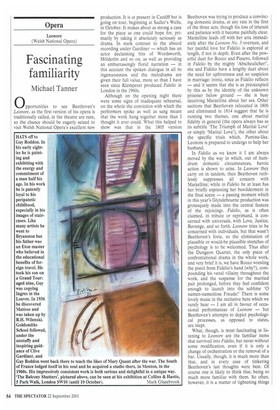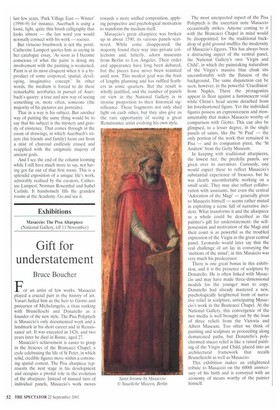Opera
Leonore (Welsh National Opera)
Fascinating familiarity
Michael Tanner
0 pportunities to see Beethoven's Leonore, as the first version of his opera is traditionally called, in the theatre are rare, so the chance should be eagerly seized to visit Welsh National Opera's excellent new production. It is at present in Cardiff but is going on tour, beginning at Sadler's Wells, in October. It makes about as strong a case for the piece as one could hope for, primarily by taking it absolutely seriously as drama. In stark contrast to the absurd recording under Gardiner — which has an actor declaiming bits of Wordsworth, Holderlin and so on, as well as providing an embarrassingly florid narration — in this account the spoken dialogue in all its ingenuousness and the melodrama are given their full value, more so than I have seen since Klemperer produced Fidelio in London in the 1960s.
Although on the opening night there were some signs of inadequate rehearsal, on the whole the conviction with which the performers spoke as well as sang meant that the work hung together more than I thought it ever could. What this helped to show was that in the 1805 version Beethoven was trying to produce a convincing domestic drama, at any rate in the first of the three acts, though his loss of interest and patience with it become painfully clear. Marzelline leads off with her aria immediately after the Leonore No. 3 overture, and her painful love for Fidelio is explored at length, if not in depth. Even after the powerful duet for Rocco and Pizarro, followed in Fidelio by the mighty `Abscheulicher!', she and Fidelio have a lengthy duet about the need for upfrontness and no suspicion in marriage: ironic, since as Fidelio reflects — and it seems that she is as preoccupied by this as by the identity of the unknown prisoner below ground — she is busy deceiving Marzelline about her sex. Other sections that Beethoven relocated in 1806 and eliminated in 1814 suggest that he is running two themes, one about marital fidelity in general (the opera always has as its subtitle The Triumph of Marital Love' or simply 'Marital Love'), the other about the specific trials which, Pamina-like, Leonore is prepared to undergo to help her husband.
In Fidelio as we know it I am always moved by the way in which, out of humdrum domestic circumstances, heroic action is shown to arise. In Leonore they carry on in tandem, then Beethoven ruthlessly suppresses all concern with Marzelline; while in Fidelio he at least has her briefly expressing her bewilderment in the final scene — a passing moment which in this year's Glyndebourne production was grotesquely made into the central feature of the rejoicings. Fidelio, as is often claimed, in tribute or reprimand, is concerned with universals, with Love, Justice, Revenge, and so forth. Leonore tries to be concerned with individuals, but that wasn't Beethoven's forte, so the elimination of plausible or would-be plausible stretches of psychology is to be welcomed. Thus after the Dungeon Quartet, the only piece of confrontational drama in the whole work, and very brief it is, we have Rocco wresting the pistol from Fidelio's hand (why?), compounding his venal villainy throughout the work, and the suspense for the married pair prolonged, before they feel confident enough to launch into the sublime '0 namen-namenlose Freude!' There is some lovely music in the recitative here which we rarely hear — I am all in favour of occasional performances of Leonore — but Beethoven's attempts to depict psychological processes, as opposed to states, are inept.
What, though, is most fascinating in listening to Leonore are the familiar items that survived into Fidelio, but never without some modification, even if it is only a change of orchestration or the removal of a bar. Usually, though, it is much more than that, and in every case of tinkering Beethoven's last thoughts were best. Of course one is likely to think that, being so much more familiar with them. So often, however, it is a matter of tightening things last few years, 'Park Village East — Winter' (1998-9) for instance, Auerbach is using a loose, light, quite thin brush calligraphy that looks almost — the last word you would normally connect with his work — rococo.
But virtuoso brushwork is not the point. Catherine Lampert quotes him as saying in her catalogue essay, 'As soon as I become conscious of what the paint is doing my involvement with the painting is weakened. Paint is at its most eloquent when it is a byproduct of some corporeal, spatial, developing, imaginative concept.' In other words, the medium is forced to do these remarkable acrobatics in pursuit of Auerbach's quarry: a true and new way of seeing something or, more often, someone (the majority of his pictures are portraits).
That in a way is his subject. But another way of putting the same thing would be to say that his subject is the mystery and gravity of existence. That comes through in the room of drawings, in which Auerbach's sitters (his friends and family) loom out from a mist of charcoal endlessly erased and reapplied with the enigmatic majesty of ancient gods.
And I see the end of the column looming while I still have much more to say, not having got far out of that first room. This is a splendid exposition of a unique life's work, admirably realised by the curators, Catherine Lampert, Norman Rosenthal and Isabel Carlisle. It handsomely fills the grandest rooms at the Academy. Go and see it.











































































 Previous page
Previous page